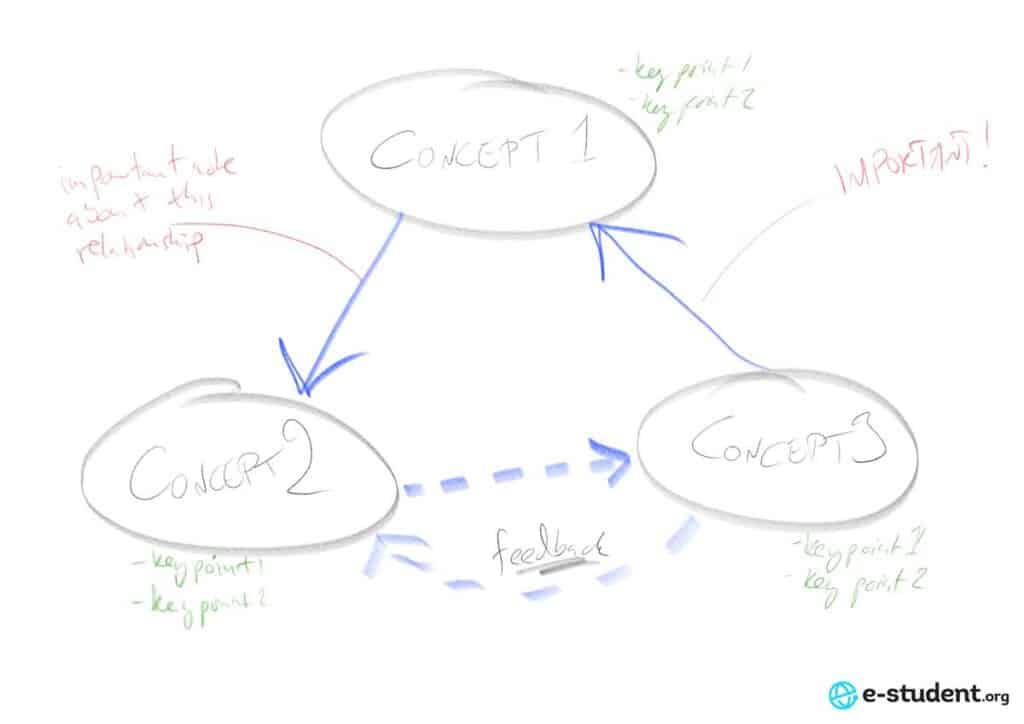- The flow note-taking method is a free-form approach to actively engaging with a topic through visually representing relationships between concepts and ideas.
- The method is flexible and suitable for most subjects.
- It is one of the more challenging methods to use live during class, as it requires you to process and represent the ideas presented to you while the lecturer is speaking.
While linear note-taking methods (such as the sentence and outline methods) have their place in your toolkit, you will want to complement these with non-linear methods that force you to actively engage with the topic at hand as a whole. Using such methods translates into a better understanding of an area and how its different component parts relate to each other. One of the main non-linear approaches that you should become familiar with is the flow method of note-taking.
Table of Contents
What is the flow method of note-taking?
The flow notetaking method, as the name indicates, focuses on how information “flows” from one concept to the next and how they all relate to each other. It is a relatively free-form method without much guidance on how to do it “correctly,” but despite that, it is a very effective approach that can suit a variety of subjects and learning styles.
While it visually can look similar to the mapping method, the focus of this method is on the higher-level concepts and ideas and how they relate to each other. Detailed descriptions and paraphernalia have to take a step back. The relationships are indicated using arrows and lines, in whichever way you find useful.
The flow method is used in two main ways:
- Live during lectures in order to actively engage with the material while the lecturer is speaking rather than just trying to transcribe what is being said
- After lectures or literature reviews to revisit the concepts studied and make sense of how it all comes together

For what types of subjects is the flow method suitable?
The flow method is a flexible method of note-taking that suits most subjects, whether humanities, social sciences, or STEM subjects, as long as relationships between concepts, ideas, or other units of information are part of what is being taught. It is particularly well suited for review lectures where you already (should) have a good idea about the topic that’s being taught. It is less suited for subjects that deal with a lot of facts (e.g., learning the names of all the bones in the human body).
Advantages and disadvantages of the flow method
While the flow method is useful across a range of different subjects, it comes with both advantages and disadvantages.
These are the primary advantages of the flow method:
- The flow method aims to have you learn during class by having you engage actively with the content.
- Even though you are actively learning during class, you also get useful notes for revision – while the notes are not in the most useful format for revision, they tend not to be terrible
- It’s a flexible method that suits most subjects.
- It is a good choice for note-taking after having followed a class or after having read all material to solidify your understanding.
- The method can be personalized to suit individuals’ needs and preferences.
On the other hand, these are the main disadvantages of the flow method:
- The flow method is not well suited for topics of which you have no prior understanding, as it can be difficult to pick out what is more or less important and figure out how they relate to each other during the class.
- While engaging mainly with the bigger picture, you risk missing important details during lectures.
- Flow notes can easily turn out quite messy and are not ideal for revision (you can try to mitigate this by adding cue words to your notes to prompt you to describe relationships during revisions).
- It can be difficult to find the time to actively engage with a topic during fast-paced lectures, forcing you to take detailed notes and apply the flow method after class instead.
- Practice with the method is needed as you need to figure out how to best use it to suit your learning style.
How to take notes with the flow method
To take and use notes with the split-page method, follow these steps:
Preparations
The flow method is best done using a pen or pencil and paper. This will allow you to draw and write in any way you like without having to worry about any limitations in the software.
If you prefer having all your notes digitally, or have a paper allergy (it’s a thing!), then make sure you use a tablet with a pen or other note-taking solution that allows you to write and draw freely.
You can, however, also use a computer for split-page notes. My recommendation is to write your notes in a two-column table. You can do this either in a word processor or in a spreadsheet.
Preformat the table so that the column width is approximately 20% for column one and 70% for column two. This way, by making sure you use a new column row when you move to a new keyword/cue, you can ensure that your notes are aligned. If using a word processor, don’t format the document directly to have columns, or you will struggle to keep the keywords and notes lined up. Instead, insert a table into the document. Alternatively, if you have specialized note-taking software that can handle split-page notes, then you can, of course, use that.
Write down the main concepts
Start with writing down the main concepts, themes, or similar. Depending on the pace of a lecture, you may need to write down several of these while waiting for a bit of a lull to move to step 2 (if following a recorded lecture, the pause button is your friend).
At this stage, try to focus on the top-level concepts that you’re dealing with, and do not get bogged down in details. But if you’re not familiar enough with the topic to determine what are the key points, certainly feel free to add details already at this stage – you can always rewrite the notes if you’re not happy with the level of detail.

Add relationships and details
When you have a chance during class (or after a fast-paced class if the moment never comes), think of how the concepts relate to each other and draw arrows and lines to represent those.
Use a notational system that makes sense to you, such as solid lines for strong relationships and dotted lines for weaker relationships – but regardless, I would recommend not being too strict so as not to get held up thinking about exactly how to represent relationships. The most important thing is that you actively engage with the material to better internalize how it all comes together.
This is also a good time to add additional explanatory notes, highlight certain words, etc., although this you may need to do afterward when reviewing your notes.
Studying with your flow notes
Like all note-taking, the most important thing is to actually use your notes when revising. With the flow method, you will have a good source of high-level notes. They are, however, not ideally formatted for revising, as the concepts tend to be all over the page. A tip is to add cue words for different sections of your flow notes.
When revising, cover over the notes. Go through the keywords/cues one by one and try to list the concepts and describe how they are related. If possible, speak out loud and try to speak with confidence. This can be helpful even if you are preparing for a written exam.
An alternative useful method to using flow notes for revising is to take your existing notes and material and have a central part of your revision being preparing flow notes. This will help you synthesize the different components of the course – and you can then also of course use these notes for further revision.
Tips for useful split-page notes

Effective flow notes tend to need you to develop a personal style, and you will need to figure out what works best for you. But think in particular of the following when working on your flow notes:
- It’s the looks that count: Keep your notes simple and put the focus on the visual representation of the interconnections to help build your understanding.
- Focus on the big picture: Don’t copy the lecturer word-for-word – the flow method is about actively engaging with the course material at a higher level.
- Come prepared: Your flow notes will be greatly facilitated if you already have an idea about what are the main concepts covered in a class. Review in advance any course syllabus, course reading, or other information ahead of the class. That way, you’ll know better which concepts and details to include in your notes.
- Record if possible: As you will be engaging your brain to understand the big picture, you may miss details that turn out to be important. See if it is possible to record the lecture so that you can refer to it later if needed. Set up an audio recorder (if the lecturer allows it) or ask for someone else’s recording. If following an online class, ask if there will be a recording made available or if it is ok that you record on your computer.
- Use colors: To keep the relationships clear and to be able to add additional detail without detracting too much from the big picture, use different colors for the different dimensions and/or levels of importance.

How does the split-page method relate to other note-taking methods?
On the face of it, the flow method of note-taking looks a lot like the mapping (or mind map) method, as both make use of lines and arrows to show the relationships of different components. However, while the mapping method is, in general, used for data with fairly straightforward hierarchical relationships (starting with a main concept and working your way down through the levels of components or subcategories of it), the flow method does not have that kind of restriction on the direction or number of relationships, supporting notes, or similar. This makes the flow method more suitable for a wider range of information, but on the other hand, the notes tend to be quite a lot messier.
The flow method follows a very different approach from linear methods of note-taking – but they all fill important slots in your note-taking toolkit. I would recommend you familiarize yourself with some of the other best note-taking methods to complement the flow method.



